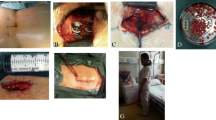Abstract
This study is to compare the therapeutic effect of posterior lumbar interbody fusion (PLIF) and transforaminal lumbar interbody fusion (TLIF) with pedicle screw fixation on treatment in adult degenerative spondylolisthesis. A retrospective analysis of 187 patients to compare the complications and associated predictive factors of the two techniques of one level lumbar fusion. Ninety-one had PLIF with two cages and pedicle fixation (group 1), and ninety-six had TLIF with one cage and pedicle fixation (group 2). The two groups had similar age and sex distribution, and level of pain. Inclusion criteria and outcome measurements were identical in both groups. The two groups were operated on with autograft and cage with pedicle fixation. Before surgery and at the 2-year follow-up, pain (VAS) and functional disability (JOA) were quantified. The results showed there were no intraoperative deaths in our study. In the end 176 cases had 2-year follow-up while 11 cases were lost to follow-up. The follow-up rate was 93.4% (85/91) in the PLIF group and 94.8% (91/96) in the TLIF group. All patients had bone fusion, and there were no cases of cage extrusion. The pain index improved from 7.08 ± 1.13 to 2.84 ± 0.89 in PLIF patients and improved from 7.18 ± 1.09 to 2.84 ± 0.91 in TLIF patients (P < 0.001). There were 42 cases of excellent, 29 cases of good, 11 cases of general, and 3 cases of poor results in PLIF group. There were 46 cases of excellent, 31 case of good, 12 case of general, and 2 cases of poor results in TLIF group. The JOA score in all patients was 84.1% of good or excellent (83.5% in PLIF and 84.6% in TLIF, P > 0.05). The average preoperative slip was 30.1 ± 7.2% in PLIF group while in the TLIF it was 31.4 ± 8.3%. Immediately post operatively it was reduced to 7.3 ± 2.1% and 7.4 ± 2.7% and at last F/U it was 8.1 ± 2.8% and 8.2 ± 2.6%, respectively. The average of reduction rate was 75.2 ± 6.4% in PLIF and 75.4 ± 6.2 in TLIF on the initial post operatively X-ray, and 72.6 ± 5.2% and 72.4 ± 5.4% on the follow-up. The percentage rate, reduction rate and lost of reduction rate between the two groups was similar (P > 0.05). The average pre operative disk and foramen height in the PLIF group improved from 6.8 ± 2.3 and 14.2 ± 1.7 preoperatively to 11.6 ± 1.5 and 18.7 ± 1.8 post operatively, respectively. At last follow up there was minimal lost of correction down to 11.24 ± 1.2 and 18.1 ± 1.8, respectively. Similarly in the TLIF group, pre operative disk and foramen height were improved from 6.7 ± 1.7 and 14.1 ± 1.8 to 11.4 ± 1.6 and 18.5 ± 1.6 immediately post operative. At last follow up minimal lost of correction was noted with average disc height of 11.3 ± 1.4 and 18.2 ± 1.7. Both techniques achieve statistical significance in restoration of disc and foraminal (P < 0.01); however, there was no statistical difference between the two techniques. In conclusion, interbody fusion with either a PLIF technique or a TLIF technique provides good outcomes in the treatment of adult degenerative spondylolisthesis. The TLIF procedure is simpler and is as safe and effective as the PLIF technique.


Similar content being viewed by others
References
Cloward R (1953) The treatment of ruptured lumbar intervertebral discs by vertebral body fusion. J Neurosurg 10:154–168
Evans JH (1985) Biomechanics of lumbar fusion. Clin Orthop 193:38–46
Gertzbein SD, Betz R, Clements D et al (1996) Semirigid instrumentation in the management of lumbar spinal conditions combined with circumferential fusion. A multicenter study. Spine 21:1918–1925. doi:10.1097/00007632-199608150-00018
Goel VK, Kong W, Han JS et al (1993) A combined finite element and optimization investigation of lumbar spine mechanics with and without muscles. Spine 18:1531–1541
Harms J (1992) Screw-threaded rod system in spinal fusion surgery. Spine 6:541–575
Harms JG, Jeszenszky D (1998) The unilateral, transforaminal approach for posterior lumbar interbody fusion. Orthop Traumatol 6:88–99
Humphreys SC, Hodges SD, Patwardhan AG et al (2001) Comparison of posterior and transforaminal approaches to lumbar interbody fusion. Spine 26:567–571. doi:10.1097/00007632-200103010-00023
Ishihara H, Osada R, Kanamori M et al (2001) Minimum 10-year followup study of anterior lumbar interbody fusion for isthmic spondylolisthesis. J Spinal Disord 14:91–99. doi:10.1097/00002517-200104000-00001
Lin PM (1977) A technical modification of Cloward’s posterior lumbar interbody fusion. Neurosurgery 1:118–124. doi:10.1097/00006123-197709000-00006
Patwardhan AG, Havey RM, Meade KP et al (1999) A follower load increases the load-carrying capacity of the lumbar spine in compression. Spine 24:1003–1009. doi:10.1097/00007632-199905150-00014
Spruit M, Pavlov PW, Leitao J et al (2002) Posterior reduction and anterior lumbar interbody fusion in symptomatic low-grade adult isthmic spondylolisthesis: short-term radiological and functional outcome. Eur Spine 11:428–433. doi:10.1007/s00586-002-0400-3
Steffee AD, Sitkowski DJ (1988) Posterior lumbar interbody fusion and plates. Clin Orthop 227:99–102
Stonecipher T, Wright S (1989) Posterior lumbar interbody fusion with facet-screw fixation. Spine 14:468–471. doi:10.1097/00007632-198904000-00026
Voor MJ, Mehta S, Wang M et al (1998) Biomechanical evaluation of posterior and anterior lumbar interbody fusion techniques. J Spinal Dis 11:328–334. doi:10.1097/00002517-199808000-00011
Yang SW, Langrana NA, Lee CK (1986) Biomechanics of lumbosacral spinal fusion in combined compression-torsion loads. Spine 11:937–941. doi:10.1097/00007632-198611000-00014
Author information
Authors and Affiliations
Corresponding author
Rights and permissions
About this article
Cite this article
Yan, Dl., Pei, Fx., Li, J. et al. Comparative study of PILF and TLIF treatment in adult degenerative spondylolisthesis. Eur Spine J 17, 1311–1316 (2008). https://doi.org/10.1007/s00586-008-0739-1
Received:
Revised:
Accepted:
Published:
Issue Date:
DOI: https://doi.org/10.1007/s00586-008-0739-1




